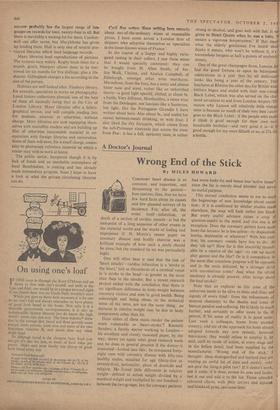A Doctor's Journal
Wrong End of the Stick
By MILES HOWARD
CORONARY heart disease is so common, and important, and threatening to the patient— how curious, then, that we have few hard facts about its causes and few planned surveys of its incidence. For, after all, the event itself—infarction, or death of a section of cardiac muscle—is but the end-point of a long sequence of other events in the material world and the world of feeling and experience (J. N. Morris's recent paper on coronary disease and bodily exercise was a brilliant example of how such a study should be done, but the standard he set was particularly high).
One will often hear it said that the risk of 'heart attacks'—cardiac infarction is a 'stroke in the heart,' just as thrombosis of a cerebral vessel is 'a stroke in the head'—is greater in the stout man than in the slender. But a recent research project ended with the conclusion that there is no significant difference in body-weight between coronary victims and men in good health. Being overweight and being obese, in the technical sense of the term, are not the same thing : an increase in relative weight may be due to body components other than fat.
Does either of these states render the patient more vulnerable to `heart-stroke/ Kenneth Sanders, a family doctor working in London— his excellent and closely reasoned paper, by the way, shows yet again what good research work can be done in general practice if the doctor is interested—looked into this: he compared forty- eight men with coronary disease with fifty-two healthy males, matched for age (thirty-five to seventy-five), nationality, place of domicile and religion. He found little difference in relative weight—defined as actual weight divided by a standard weight and multiplied by one hundred— between the two groups; but the coronary patients had more body-fat and hence less 'active tissue': since the fat is merely dead blubber and serve no useful purpose.
This second conclusion seems to me to mark the beginnings of new knowledge about causa• tion : if it is confirmed by similar studies made elsewhere, the map will look rather less blank. But every useful advance raises a crop of question-marks in the mind, and this one is no exception. Does the coronary patient have more body-fat because he is less active—by disposition, inertia, depression or whatever? With less exer• tion, his coronary vessels have less to do : do they 'silt up'? How far is this inactivity remedi• able by a resolve of the 'ego'—to run up stairs, play games and the like? Or is it compulsive, in the sense that conscious purpose will be opposed, and in the main defeated, by a stronger drive with unconscious roots? And when the silting tendency is already present, what brings about the final stroke?
Note that an explorer in this zone of the unknown needs to be alive to hints and clues and signals of every kind: from the refinements of enzyme chemistry to the shades and tones of human passion and suffering. He is likely to reach further, and certainly to offer more to the ill person, if his sense of reality is in good order. Last week a colleague, home from another country, told me of the approach his hosts always adopted towards any new remedy, however innocuous; they would refuse to employ it, he said, until its mode of action, at every stage and in the fullest detail, had been supplied by the manufacturer. 'Wrong end of the stick,' I thought : these distinguished and learned men are wasting an awful lot of time and money—whY not give the thing a pilot run? If it doesn't work, put it aside; if it does, review its uses and limits, test it out and add it to the list. Those splendid coloured charts, with their arrows and squarea and blocks of print, can come later.






































 Previous page
Previous page